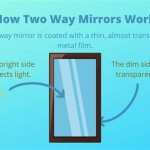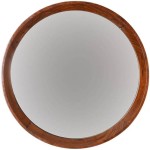How To Hang Up A Big Mirror
Hanging a large mirror can dramatically enhance a room's aesthetic, creating a sense of spaciousness and reflecting light to brighten the area. However, due to their weight and fragility, large mirrors present a unique set of challenges. Proper planning, the right tools, and a meticulous approach are crucial to ensuring the mirror is hung safely and securely, preventing damage to both the mirror and the wall. This article provides a comprehensive guide to hanging a large mirror, covering essential preparatory steps, different hanging methods, and safety considerations.
Assessing the Mirror and Wall
Before attempting to hang a large mirror, it is imperative to thoroughly assess both the mirror itself and the wall on which it will be mounted. This evaluation will inform the subsequent steps and determine the appropriate hanging hardware and techniques.
Mirror Inspection: Begin by carefully inspecting the mirror for any existing damage, such as cracks, chips, or loose backing. Document any pre-existing flaws before commencing the installation. Furthermore, measure the precise dimensions of the mirror, including its thickness and the location of any pre-installed mounting hardware, such as D-rings or wire. Note the mirror's weight. This information is usually found on the packaging or can be estimated based on the mirror’s dimensions and construction material. Knowing the weight is critical for selecting appropriately rated hardware.
Wall Evaluation: The wall's construction material is a primary factor determining the type of anchors required. Identify whether the wall is drywall, plaster, brick, or concrete. Drywall and plaster are weaker and require specialized anchors designed to distribute weight effectively. Brick and concrete walls, on the other hand, necessitate drilling and the use of masonry anchors. If the structure of the wall is not apparent, a stud finder should be used to locate studs. Studs are vertical framing members that provide significant structural support. Hanging the mirror directly on or near a stud whenever possible is the safest and most reliable option.
If the wall is drywall, carefully assess its condition. Look for signs of water damage, such as stains or discoloration, as this can compromise the drywall's integrity. Also, check for any pre-existing damage, such as holes or cracks, which should be repaired before hanging the mirror. The location of electrical wiring and plumbing within the wall must also be considered. A stud finder with AC wire detection can help identify potential hazards. Avoid drilling or hammering in areas where wiring or plumbing may be present to prevent damage or injury.
Gathering Necessary Tools and Materials
Having the right tools and materials on hand is crucial for a successful and safe mirror-hanging project. The specific items required will depend on the size and weight of the mirror, as well as the type of wall. A comprehensive checklist should include:
Measuring Tools: A tape measure is essential for accurately determining the desired height and position of the mirror on the wall. A level is necessary to ensure the mirror is hung straight and prevents a tilted appearance. A pencil is used to mark the locations of the mounting hardware on the wall. A stud finder helps locate wall studs for maximum support.
Drilling and Fastening Tools: A drill is required for creating pilot holes and installing anchors. Select drill bits appropriate for the wall material (e.g., drywall, wood, brick). Screwdrivers are needed to tighten screws into the anchors. Consider both Phillips head and flathead screwdrivers to match the screw types.
Hanging Hardware: The choice of hanging hardware is critical for ensuring the mirror is securely mounted. For drywall, consider using heavy-duty drywall anchors, such as toggle bolts or self-drilling anchors, which can support significant weight. For brick or concrete walls, use masonry anchors specifically designed for these materials. Picture-hanging wire or D-rings, if not already attached to the mirror, may be needed to interface with the wall-mounted hardware. Select screws that are the appropriate length and gauge for the chosen anchors and the mirror's hanging hardware. Safety glasses are essential to protect eyes from debris while drilling. Gloves provide a better grip and protect hands. A dust mask is recommended to avoid inhaling dust particles during drilling.
Additional Supplies: Painter's tape can be used to mark the desired location of the mirror on the wall and to prevent the drywall from chipping during drilling. A damp cloth can be used to clean the wall and remove any dust or debris before hanging the mirror. Drop cloths protect the floor from dust and debris generated during the drilling process.
Executing the Hanging Process
Once the assessment is complete and the necessary tools and materials are gathered, the actual hanging process can begin. This stage requires precision and attention to detail to ensure a secure and aesthetically pleasing installation.
Preparation: Begin by covering the floor with drop cloths to protect it from dust and debris. Use painter's tape to mark the desired height and location of the mirror on the wall. This will serve as a visual guide and prevent errors. Double-check the measurements to ensure the mirror will be positioned correctly.
Installing Anchors: If the mirror will be hung on drywall and a stud cannot be located, drywall anchors must be installed. Follow the manufacturer's instructions for the chosen anchor type. Typically, this involves drilling pilot holes, inserting the anchors, and securing them in place. Ensure the anchors are flush with the wall surface and can support the weight of the mirror. For brick or concrete walls, use a masonry drill bit to create pilot holes according to the anchor manufacturer's instructions. Insert the masonry anchors into the holes and tap them gently with a hammer until they are flush with the wall. For stud mounting, drive screws directly into the stud, which requires no anchor.
Hanging the Mirror: With the anchors or screws in place, carefully lift the mirror and align the hanging hardware (e.g., D-rings or wire) with the anchors or screws on the wall. If using picture-hanging wire, ensure it is securely attached to the D-rings and that the wire is strong enough to support the mirror's weight. Gently lower the mirror onto the anchors or screws, ensuring it is properly seated and balanced. Take a step back and visually inspect the mirror to ensure it is level. Use a level to confirm the alignment and make any necessary adjustments. If the mirror is not level, slightly adjust the position of one or more of the anchors or screws until it is perfectly aligned.
Securing the Mirror: Once the mirror is level, further secure it to the wall. Depending on the mirror's design and the chosen hanging method, this may involve tightening screws, adding additional supports, or applying adhesive to the back of the mirror. If using adhesive, follow the manufacturer's instructions carefully and allow sufficient time for the adhesive to cure before removing any temporary supports. Some large mirrors may require additional support at the bottom to prevent them from tilting forward. This can be achieved by using shims or specially designed mirror supports. These supports should be placed discreetly beneath the mirror to provide additional stability without detracting from its appearance. After the mirror is securely hung, remove the painter's tape and clean the wall around the mirror to remove any dust or debris. Inspect the installation one final time to ensure everything is secure and aligned correctly.

How To Hang A Heavy Mirror C R F T

How To Hang A Heavy Full Length Leaner Mirror On The Wall House Of Hepworths

How I Installed A Really Big Mirror Merrypad Diy Network

How To Hang A Mirror Perfectly

How To Hang A Heavy Full Length Leaner Mirror On The Wall Hanging Over Door

How I Installed A Really Big Mirror Merrypad Diy Network

How To Hang Heavy Mirrors Frames Without Nails 3m

How To Hang A Heavy Mirror Securely Bob Vila

How To Hang A Mirror With Wire Pictures Wikihow Picture Hanging Heavy

Asheville Art Blog Local Consultants Explore Collections And Installations Installers








